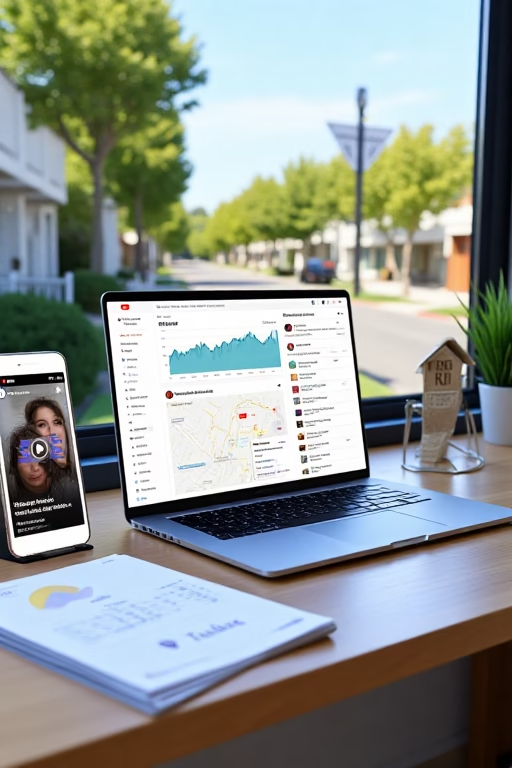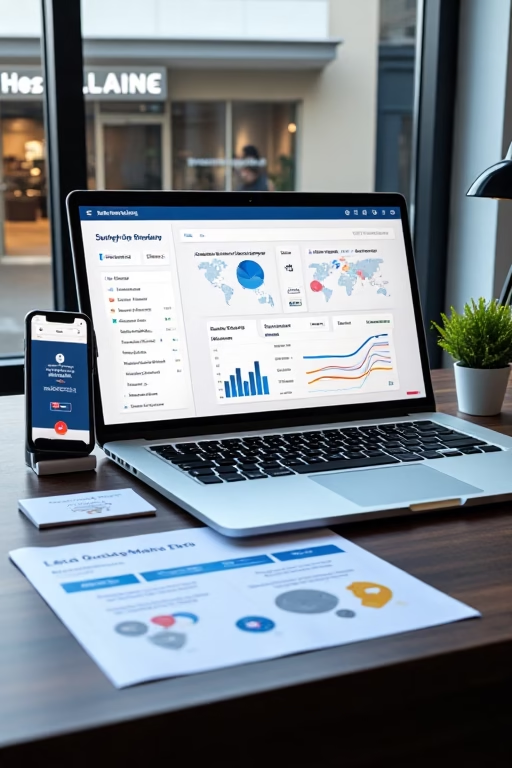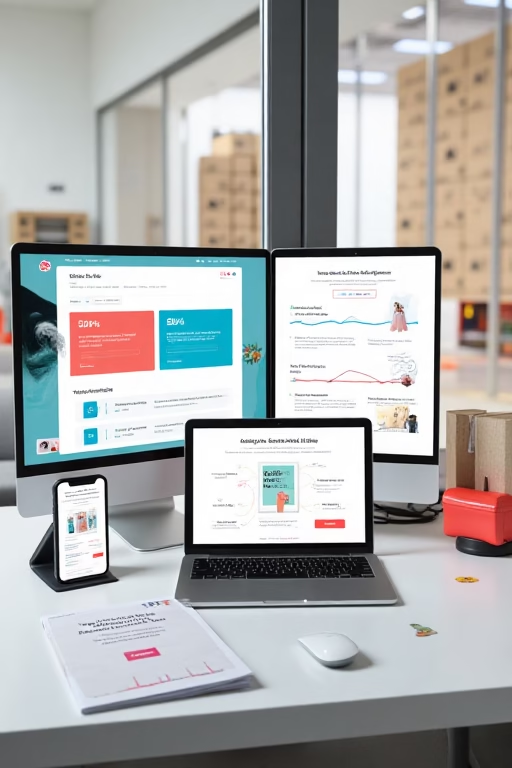How to Sell More Real Estate with YouTube: Optimizing for Local Buyers
How to Sell More Real Estate with YouTube: Optimizing for Local Buyers
Your Local Buyer YouTube Blueprint by Market Wiz
Table of Contents
- Introduction: YouTube’s Role in Local Real Estate
- 1. Understanding Your Local Buyer Personas
- 1.1 First-Time Homebuyers
- 1.2 Move-Up Buyers
- 1.3 Downsizers & Retirees
- 1.4 Investors & Landlords
- 2. Optimizing YouTube Videos for Local Search
- 2.1 Local Keyword-Rich Titles & Descriptions
- 2.2 Geo-Targeted Tags & Thumbnails
- 2.3 Neighborhood Tour Footage
- 2.4 Captions, Transcripts & Schema
- 3. Content Ideas to Attract Local Buyers
- 3.1 Virtual Open House Walkthroughs
- 3.2 Community & School Spotlights
- 3.3 Agent Introductions & Testimonials
- 3.4 Home Improvement & Staging Tips
- 4. Enhancing Your YouTube Channel
- 4.1 Branded Channel Layout
- 4.2 Playlists by Neighborhood & Price Range
- 4.3 Channel Trailer for Local Viewers
- 5. Driving Traffic & Engagement
- 5.1 YouTube Ads with Radius Targeting
- 5.2 Cross-Promotion on Social & Email
- 5.3 Community Q&A & Live Streams
- 6. Conversion & Lead Capture Tactics
- 6.1 End Screens & Info Cards
- 6.2 Link to Local Landing Pages
- 6.3 Integration with CRM & Forms
- 7. Measuring Success & Iteration
- Conclusion & Next Steps
- 25 Frequently Asked Questions
- 25 Extra Keywords
Introduction: YouTube’s Role in Local Real Estate
With over 2 billion users monthly, YouTube offers real estate professionals a unique platform to showcase homes, neighborhoods, and expertise directly to local buyers. By optimizing your video content for local search and crafting engaging neighborhood-focused series, you can attract qualified leads, build trust, and accelerate property sales.
1. Understanding Your Local Buyer Personas
1.1 First-Time Homebuyers
Young professionals and families entering the market seek guidance. Videos that demystify financing, explain first-time incentives, and showcase starter homes resonate strongly.
1.2 Move-Up Buyers
These buyers look for space, better schools, and community lifestyle. Highlight larger floor plans, top-rated districts, and recent renovations.
1.3 Downsizers & Retirees
Retirees often prefer low-maintenance living and accessibility features. Create content on single-story homes, community amenities, and local healthcare facilities.
1.4 Investors & Landlords
Investor audiences value rental yield, neighborhood growth, and market trends. Produce market update videos, cap rate calculators, and tenant profile insights.
2. Optimizing YouTube Videos for Local Search
2.1 Local Keyword-Rich Titles & Descriptions
Include neighborhood names, “homes for sale in [Area]” and price ranges in titles and the first 100 characters of descriptions for higher local visibility.
2.2 Geo-Targeted Tags & Thumbnails
Use tags like the city, suburb, and zip code. Design thumbnails featuring recognizable landmarks, street signs, or map overlays.
2.3 Neighborhood Tour Footage
Film local parks, schools, and shopping districts to give viewers a sense of place—use aerial drone shots to add production value.
2.4 Captions, Transcripts & Schema
Auto-generate captions and upload accurate transcripts. Apply VideoObject schema on your website embeds to boost SEO.
3. Content Ideas to Attract Local Buyers
3.1 Virtual Open House Walkthroughs
Offer guided tours of new listings with live voiceover, highlighting key features and neighborhood context.
3.2 Community & School Spotlights
Interview local business owners, showcase top schools, and highlight upcoming community events to appeal to lifestyle-focused buyers.
3.3 Agent Introductions & Testimonials
Build personal connection by featuring agent profiles, success stories, and client testimonials on video.
3.4 Home Improvement & Staging Tips
Demonstrate staging techniques, minor renovation ROI, and curb appeal hacks to establish authority.
4. Enhancing Your YouTube Channel
4.1 Branded Channel Layout
Customize your channel art with local imagery and ensure consistent branding across thumbnails and banners.
4.2 Playlists by Neighborhood & Price Range
Organize content into playlists like “Downtown Condos Under \$500K” or “Family Homes in [Suburb]” for easy discovery.
4.3 Channel Trailer for Local Viewers
Create a short trailer introducing your services, local expertise, and invitation to subscribe for neighborhood updates.
5. Driving Traffic & Engagement
5.1 YouTube Ads with Radius Targeting
Run TrueView and Discovery ads restricted to a 10–20 mile radius around your market area to reach active local shoppers.
5.2 Cross-Promotion on Social & Email
Embed videos in your email newsletters and share clips on Facebook and Instagram with a link back to YouTube for full tours.
5.3 Community Q&A & Live Streams
Host live sessions answering viewer questions about market trends, pricing, and buying process to foster trust.
6. Conversion & Lead Capture Tactics
6.1 End Screens & Info Cards
Use end screens to link to contact forms or local landing pages. Info cards can highlight special offers or highlight other property videos.
6.2 Link to Local Landing Pages
Ensure video descriptions and on-screen CTAs point to geo-specific pages on your website with inquiry forms.
6.3 Integration with CRM & Forms
Automate YouTube lead data with your CRM. Use tools like Zapier to push form submissions and track video source.
7. Measuring Success & Iteration
- Watch Time & View Rate: Gauge content engagement and identify top-performing videos.
- Click-Through Rate (CTR): Monitor how many viewers click CTAs or visit your site from videos.
- Leads Generated: Track inquiries and form fills attributed to YouTube traffic.
- A/B Testing Variations: Test different hooks, thumbnails, and CTAs to continually improve results.
Conclusion & Next Steps
YouTube offers real estate professionals a powerful, scalable way to reach local buyers with immersive video content. Begin by defining your neighborhood personas, optimizing one video for local SEO, and setting up a targeted ad campaign. Then measure engagement, refine your creative, and expand your channel to drive more qualified leads and property sales.
25 Frequently Asked Questions
1. How do I rank videos locally?
Use neighborhood names in titles, descriptions, tags, and include local landmarks in footage.
2. What video length works best?
5–7 minutes for property tours; 15–30 seconds for teasers and ads.
3. Do I need professional equipment?
Smartphone cameras with gimbals can suffice—focus on good lighting and clear audio.
4. How often post?
1–2 videos per week to maintain channel activity and subscriber engagement.
5. What’s a good thumbnail size?
1280×720 pixels with clear text and high-contrast imagery.
6. Should I add music?
Use royalty-free background music at low volume to set mood without distracting.
7. How to get more subscribers?
End each video with a clear ask to subscribe and highlight channel benefits.
8. Can I use captions?
Yes—captions improve accessibility and SEO when properly uploaded.
9. What CTA works best?
“Schedule a Virtual Tour” or “View Local Listings Now” tied to clickable links.
10. How to track leads?
Use UTM parameters on links and integrate with CRM to attribute form fills to YouTube.
11. Should I livestream?
Live tours and Q&A sessions build real-time engagement and trust.
12. How to optimize mobile?
Ensure text on thumbnails is legible on small screens and keep CTAs visible.
13. What’s a channel trailer?
A short video that introduces your brand and invites visitors to subscribe.
14. How to engage comments?
Reply promptly, pin top comments, and ask questions to spark discussion.
15. Are playlists important?
Yes—playlists keep viewers watching related videos, boosting watch time.
16. How to use end screens?
Link to key landing pages, other videos, or subscription prompts in the last 5–20 seconds.
17. What metrics matter most?
Watch time, CTR, conversion rate, and subscriber growth.
18. How often refine targeting?
Every 2–4 weeks based on campaign performance data.
19. Can I repurpose TikToks?
Yes—trim vertical clips to fit YouTube Shorts for cross-platform reach.
20. Should I use influencers?
Partner with local lifestyle influencers to showcase neighborhoods and listings.
21. How to handle copyright?
Use licensed music and obtain permissions for any third-party content.
22. What’s a good posting schedule?
Consistency—same days and times each week builds viewer habit.
23. How to improve video SEO?
Add chapters, detailed descriptions, and include target keywords early.
24. Do ads boost organic reach?
Ad campaigns can increase channel authority and visibility, aiding organic growth.
25. What’s the first step?
Film a 2–3 minute neighborhood tour and optimize its metadata for your local area.
25 Extra Keywords
- neighborhood home tours YouTube
- real estate video SEO
- local home for sale videos
- YouTube channel realtors
- in-market home buyer targeting
- radius targeting YouTube ads
- property video thumbnail tips
- virtual open house video
- YouTube end screen CTA
- real estate channel trailer
- neighborhood market update video
- suburb school tour YouTube
- real estate ad view rate
- YouTube live Q&A realtors
- playlists for home listings
- video transcript for SEO
- captions real estate videos
- mobile-first video design
- YouTube Shorts real estate
- influencer property tours
- you tube property ads
- watch time optimization
- channel analytics realtors
- local buyer engagement video
- Market Wiz real estate guide
How to Sell More Real Estate with YouTube: Optimizing for Local Buyers Read More »







3. Social Media Prospecting
3.1 LinkedIn InMail & Connection Strategies
Target decision‑makers with personalized InMail highlighting market insights and invite them to a free consultation.
3.2 Facebook Group Engagement & Ads
Join local community groups to share expertise, then run Lead Ads offering free policy reviews to members.
3.3 Twitter Listening & Outreach
Monitor keywords like “need home insurance” and reply with value, then invite prospects to DM for a personalized quote.